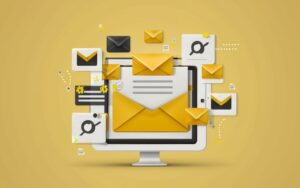Have you ever found yourself staring at your computer or phone screen, muttering, “Where is my inbox?” It’s a question more common than you might think. With a multitude of email services and platforms flooding our devices, locating and organizing your inbox can sometimes feel like navigating a digital labyrinth. However, understanding how to efficiently access and manage your inbox can save you precious time and increase your productivity significantly.
You’ll learn:
- Understanding Different Email Platforms
- Accessing Your Inbox Across Devices
- Email Organization and Management Tips
- Troubleshooting Common Inbox Issues
- Frequently Asked Questions (FAQs)
Understanding Different Email Platforms
The quest to find “Where is my inbox?” often begins with the platform itself. With numerous email providers like Gmail, Outlook, Yahoo, and Apple Mail, recognizing key differences in accessing and utilizing these platforms is crucial.
Gmail: Popular for its intuitive design and integration with Google services, Gmail requires logging in through a web browser or its dedicated app. Once signed in, the inbox is your landing page.
Outlook: Microsoft’s email service often comes pre-installed on Windows PCs. The navigation might seem distinct if you're switching from another provider, but accessing the inbox is straightforward once understood.
Apple Mail: Used predominantly by Mac and iPhone users, accessing your inbox on Apple Mail is seamless, especially if it is linked with your Apple ID.
Yahoo Mail: Yahoo presents a slightly different layout but finding your inbox should be intuitive after familiarization with its distinctive purple-themed interface.
Accessing Your Inbox Across Devices
Desktops and Laptops:
-
Webmail Services: Direct your browser to the service provider's website, log in with your credentials, and the inbox normally appears front and center. Webmail services include Gmail, Yahoo, and Outlook.
-
Email Clients: Programs like Microsoft Outlook or Thunderbird may require additional setup to connect them with your email service, but they integrate multiple email accounts into one interface.
Mobile Devices:
-
Mobile Applications: Almost every major email provider offers an app available through app stores. Apps typically provide push notifications and mobile-optimized views of your inbox.
-
Device Settings Integration: On both Android and iOS, you can add email accounts directly from your device's settings, syncing them with built-in mail apps for automatic inbox accessibility.
Email Organization and Management Tips
Locating your inbox is just the start. Efficiently managing large volumes of email is essential.
Use of Folders and Labels:
-
Folders (Outlook, Apple Mail): Organize emails by creating folders. Selectively move emails into these folders to declutter your main inbox.
-
Labels (Gmail): Apply labels to categorize messages, enhancing the searchability without moving them from the main inbox.
Priority Inbox and Filters:
-
Priority Inbox (Gmail): This smart feature sorts emails by importance, showing crucial emails first based on factors like your past interactions.
-
Filters: Set up filters to automatically categorize incoming emails and sort them into designated folders or label them based on criteria like sender, subject, or keywords.
Archiving and Deleting:
-
Archiving: A non-destructive method to remove emails from the inbox without deleting them. Archived emails are retrievable through a search function but do not clutter the inbox view.
-
Deleting: Permanent removal of emails you no longer need. Keep in mind, deleted emails can sometimes be recovered from the trash bin within a limited period.
Regular Maintenance: Schedule routine inbox clean-ups. Weekly or monthly maintenance helps in maintaining an organized inbox.
Troubleshooting Common Inbox Issues
Sometimes, accessing or using your inbox isn't as straightforward as it should be. Here are some typical problems and their solutions.
Can't Log In: Double-check your email address and password. If forgotten, most providers have “Forgot Password” options to help regain access.
Missing Emails:
-
Check Spam/Junk Folders: Legitimate emails sometimes end up in spam. Review these folders regularly and mark emails as “Not Spam” to adjust your filter.
-
Search Function: Leverage search tools to find specific emails by keywords, addresses, or date ranges.
Sync Issues on Mobile Devices:
- Ensure your internet connection is stable.
- Remove and re-add the email account in your device settings if sync fails consistently.
- Update the email app to the latest version to patch any bugs affecting sync.
Frequently Asked Questions (FAQs)
-
Why is my inbox empty, but I know I've received emails?
Often, this could be due to the sorting or filter settings. Check to ensure you're viewing all mail and that no conflicting filters are inadvertently directing emails elsewhere. -
How do I switch between multiple email accounts?
Most providers support multiple accounts. Use the account switcher feature, typically found in the profile or account settings section, to toggle between different accounts quickly. -
What's the difference between archiving and deleting an email?
Archiving removes an email from the inbox but keeps it retrievable in records, while deleting moves the email to the trash and eventually removes it permanently after a set period. -
Can I access my inbox offline?
Some email clients and apps offer an offline mode, allowing access to emails when not connected to the internet. Ensure offline access is enabled in the settings. -
Why is it important to regularly clear my inbox?
Routine cleaning ensures your inbox remains manageable and increases productivity. Overloaded inboxes can lead to missed important messages and contribute to unnecessary digital clutter.
Summary:
- Understand the platforms: Gmail, Outlook, Apple Mail, and Yahoo.
- Access your inbox on desktops, laptops, and mobile devices through web services and apps.
- Use organization tools like folders, labels, and filters to manage emails effectively.
- Regularly maintain and troubleshoot your inbox to avoid common issues.
- Familiarize yourself with FAQs to aid in efficient inbox management.
Accessing and managing your inbox doesn’t have to remain a daunting task. With the right knowledge and tools, finding and optimizing your email management can be a streamlined part of your daily routine. Next time you ask, “Where is my inbox?” you’ll not only know how to find it but also how to make your inbox work best for you.



